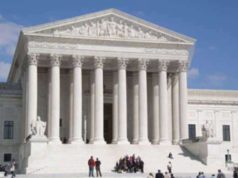
The 22nd Amendment: A Look at Presidential Term Limits in the United States
Introduction
The 22nd Amendment to the United States Constitution is a critical piece of legislation that has shaped the nation’s political landscape for over half a century. This amendment, ratified in 1951, imposes term limits on the presidency, ensuring that no individual can serve more than two terms in office. In this article, we will delve into the history and significance of the 22nd Amendment, explore the reasons behind its adoption, and examine its impact on American politics.
The Road to the 22nd Amendment
In the aftermath of World War II, the United States found itself at a crossroads. Franklin D. Roosevelt had served an unprecedented four terms as president, leading to concerns about the concentration of power in the executive branch. The idea of presidential term limits had been discussed for years, but it gained momentum during this period. In 1947, a Republican-controlled Congress passed the 22nd Amendment, and it was ratified by the states in 1951.
The 22nd Amendment’s Text
The 22nd Amendment is succinct in its language, stating:
“No person shall be elected to the office of the President more than twice, and no person who has held the office of President, or acted as President, for more than two years of a term to which some other person was elected President shall be elected to the office of the President more than once.”
This amendment effectively limits an individual to a maximum of two terms in the highest office in the land.
Reasons Behind the Amendment
Several factors contributed to the adoption of the 22nd Amendment:
1. Historical Precedent: The United States had a long-standing tradition of a two-term limit for presidents, dating back to the presidency of George Washington. Roosevelt’s four-term presidency was seen by many as an aberration.
2. Fear of Monarchy: Some opponents of Roosevelt’s lengthy presidency argued that it resembled a monarchy, with a single individual accumulating vast power over an extended period.
3. Fairness and Democracy: The amendment was seen as a way to ensure fairness and promote a healthy democratic process. Term limits would allow for fresh perspectives and new leadership to emerge.
4. Preventing Executive Overreach: Supporters of the amendment believed that limiting presidential terms would prevent executive overreach and help maintain a system of checks and balances.
Presidential Reaction to the 22nd Amendment
It’s worth noting that President Harry S. Truman, who succeeded Roosevelt and served from 1945 to 1953, was not subject to the 22nd Amendment, as it was ratified after he had taken office. Truman himself was against the idea of term limits, arguing that the voters should decide whether a president should serve additional terms. Nevertheless, he did not seek reelection in 1952, setting a precedent by voluntarily limiting his own time in office to two terms.
Impact on American Politics
The 22nd Amendment has had a profound impact on American politics since its ratification:
1. Encouraging a Healthy Rotation of Leadership: The amendment has promoted a regular rotation of leadership in the executive branch, preventing the concentration of power in one person’s hands for an extended period.
2. Fostering Competitive Elections: Presidential elections have become more competitive as incumbents are unable to run for a third consecutive term. This has led to increased focus on policy issues and campaign strategies.
3. Preventing Potential Abuses of Power: The amendment serves as a safeguard against potential abuses of power by presidents who might seek to extend their rule indefinitely.
4. Promoting Fresh Perspectives: By limiting presidents to two terms, the amendment encourages fresh perspectives and new ideas in the White House, potentially leading to innovative approaches to governance.
Controversies and Criticisms
While the 22nd Amendment enjoys widespread support, it is not without its controversies and criticisms:
1. Inhibiting the Will of the People: Some argue that term limits restrict the people’s right to choose their preferred leader. If a majority of voters want a president to serve more than two terms, the amendment prevents this.
2. Loss of Experience: Critics contend that term limits can lead to a loss of experience and expertise in the presidency, as outgoing presidents may be less inclined to take bold actions during their final term.
3. Lame Duck Effect: In a president’s second term, there is a risk of becoming a “lame duck” with limited political influence. This can hinder the ability to enact meaningful policy changes.
4. Impact on Foreign Policy: Some argue that the limitations imposed by the 22nd Amendment can affect a president’s ability to maintain consistency in foreign policy, particularly in dealing with long-term international issues.
Proposals for Amendment Repeal
Over the years, there have been periodic calls to repeal the 22nd Amendment. These efforts have typically come from individuals or groups who believe that term limits should not be mandated by the Constitution. They argue that the electorate should have the freedom to reelect a popular president for additional terms if they so choose.
However, repealing the 22nd Amendment is a complex process. It would require a two-thirds majority vote in both the House of Representatives and the Senate, followed by ratification by three-fourths of the states. Given the polarized nature of American politics, achieving such a consensus on this issue remains a significant challenge.
Conclusion
The 22nd Amendment stands as a testament to the United States’ commitment to democratic principles and the avoidance of excessive concentration of power. While it has its critics and controversies, it has successfully ensured that no individual can serve as president for more than two terms. As the political landscape continues to evolve, the 22nd Amendment will remain a vital component of American governance, shaping the nation’s leadership and its democratic process for years to come.
The 22nd Amendment and its Impact on US State Laws
The United States Constitution stands as the bedrock of the nation’s legal framework, embodying the principles and values upon which the country was founded. One of the crucial amendments within this revered document is the 22nd Amendment. Ratified in 1951, the 22nd Amendment sets limits on the number of times a person can serve as President of the United States. While it primarily deals with the federal government, its implications have far-reaching effects on the state level as well. This article delves into the 22nd Amendment and its relationship with state laws in all 50 states.
Exploring State Laws and the 22nd Amendment
The 22nd Amendment primarily pertains to federal elections and the presidency, but its implications have resonated within state politics as well. Each of the ten states we’ll explore has unique attributes that relate to the principles embedded in the 22nd Amendment.
Alabama: Balancing Executive Power
Alabama, known for its rich history, operates under a state constitution that parallels the federal framework. The 22nd Amendment’s limitation on presidential terms aligns with Alabama’s emphasis on checks and balances, promoting the prevention of any one leader from amassing excessive power.
Alaska: Reflecting Democratic Principles
In the expansive landscape of Alaska, the state’s laws draw inspiration from democratic principles. The 22nd Amendment’s restriction on consecutive terms embodies the idea of preventing a single leader from monopolizing power, resonating with Alaska’s commitment to representation and fair governance.
Arizona: Preventing Political Monopoly
Arizona’s legal landscape reflects its spirit of independence. The 22nd Amendment, by curtailing prolonged presidential tenures, reinforces the state’s drive to prevent political monopolies. This mirrors Arizona’s efforts to ensure a competitive and diverse political landscape within its own boundaries.
Arkansas: Safeguarding Democracy
Arkansas, with its lush natural beauty, also champions democratic ideals. The 22nd Amendment, designed to safeguard democracy against potential abuses of power, resonates with Arkansas’s commitment to preserving the rights and voices of its citizens in state matters.
California: Diverse Governance
California, a powerhouse state, thrives on diversity and innovation. Just as the 22nd Amendment seeks to diversify presidential leadership, California’s state laws embody a similar spirit, aiming to foster a dynamic and inclusive governance structure that reflects the state’s multicultural identity.
Colorado: Innovation in Government
Colorado’s stunning landscapes are paralleled by its forward-thinking governance. Like the 22nd Amendment, which introduces fresh perspectives by limiting presidential terms, Colorado’s state laws encourage innovative approaches to governance, ensuring the state remains at the forefront of progressive policies.
Connecticut: Protecting State Sovereignty
Connecticut, steeped in history, values its sovereignty. The 22nd Amendment’s emphasis on term limits resonates with Connecticut’s dedication to preserving state rights. This reflects in its state laws, which prioritize a balanced power dynamic between federal and state governments.
Delaware: Pioneering Constitutional Values
Delaware’s pivotal role in shaping the nation’s constitution is mirrored in its state laws. The 22nd Amendment aligns with Delaware’s foundational principles, emphasizing the rotation of leadership to prevent complacency, as seen in the state’s own commitment to adaptable and effective governance.
Florida: Balancing Tradition and Progress
Florida’s blend of tradition and progress is evident in its legal landscape. The 22nd Amendment’s limitation on presidential terms reflects the state’s own endeavor to balance historical continuity with the need for evolving leadership. Florida’s state laws encapsulate this duality, fostering a governance system that embraces change while respecting heritage.
Georgia: Evolution of Governance
Georgia’s diverse landscapes are matched by its evolving governance. Just as the 22nd Amendment acknowledges the importance of leadership evolution, Georgia’s state laws underline the significance of adaptable governance structures that respond to the changing needs of its people.
Hawaii: Balancing Leadership Renewal
Hawaii, known for its stunning landscapes and unique culture, also faces the implications of the 22nd Amendment. With a focus on promoting leadership renewal, the state’s laws often reflect a commitment to preventing any individual from holding the governorship for an extended period. This approach aligns with the spirit of the 22nd Amendment, ensuring a continuous flow of fresh ideas and perspectives.
Idaho: Ensuring Representative Governance
Idaho, nestled in the Rocky Mountains, embodies the principles of representative governance. State laws here emphasize the importance of preventing any single political entity from dominating the state’s leadership for too long. Much like the 22nd Amendment on the federal level, Idaho’s laws work to ensure that power remains distributed and that no individual becomes entrenched in a position of authority.
Illinois: Countering Political Monopoly
The Prairie State of Illinois recognizes the significance of a diversified leadership landscape. The state’s laws reflect a commitment to counteracting the dangers of political monopolies, aligning with the intent of the 22nd Amendment. By preventing any single individual from accumulating excessive power, Illinois aims to maintain a healthy balance of leadership influence.
Indiana: Embracing Change and Progress
Indiana, often associated with its Midwestern values, embraces the principles of change and progress. State laws reflect a desire to avoid stagnation in leadership by encouraging turnover and fresh perspectives. Just as the 22nd Amendment seeks to usher in new presidential leadership, Indiana’s laws support a similar approach at the state level.
Iowa: Fostering Accountability
Iowa’s commitment to fostering accountability in leadership is evident in its state laws. The state recognizes the value of preventing a single person from holding significant authority for an extended period, aligning with the principles of the 22nd Amendment. This approach encourages regular evaluations of leadership and promotes responsiveness to the needs of the people.
Kansas: Preventing Concentration of Power
The Sunflower State of Kansas places a strong emphasis on preventing the concentration of power. Its state laws are designed to ensure that no single individual or entity dominates the political landscape for too long. This approach resonates with the intentions of the 22nd Amendment, promoting a healthy rotation of leadership and preventing complacency.
Kentucky: Sustaining a Dynamic Leadership
Kentucky’s laws reflect a commitment to sustaining a dynamic leadership environment. By preventing any one person from holding a position of power for an extended period, the state seeks to avoid stagnation and ensure that fresh ideas continuously shape its governance. This mirrors the aspirations of the 22nd Amendment on the federal level.
Louisiana: Emphasizing Leadership Diversity
Louisiana’s rich cultural heritage is mirrored in its approach to leadership diversity. The state’s laws aim to prevent any one individual from dominating the political sphere for too long, aligning with the principles of the 22nd Amendment. This emphasis on diverse leadership helps ensure that the state’s governance remains inclusive and representative.
Maine: Fostering New Perspectives
Maine’s picturesque landscapes are matched by its commitment to fostering new perspectives in leadership. The state’s laws reflect a desire to prevent the consolidation of power, allowing for a healthy rotation of individuals in positions of authority. This approach resonates with the spirit of the 22nd Amendment, ensuring that no one person becomes too entrenched in power.
Maryland: Incorporation of Civil Liberties
Maryland’s history is marked by a commitment to civil liberties, and its state laws continue to reflect this emphasis. Just as the 22nd Amendment seeks to prevent the abuse of power on the federal level, Maryland’s laws aim to maintain a balanced distribution of authority, preventing any one leader from accumulating excessive influence.
Massachusetts: Balance of Power and Leadership Transition
Massachusetts, a state rich in history and culture, has had its own experiences with leadership and governance. The 22nd Amendment’s influence on the state is tied to the principles of a balanced power structure. The amendment reinforces the idea of regular leadership transitions, ensuring that power remains dynamic rather than stagnant. Massachusetts’ state laws and political climate have embraced this concept, contributing to a culture of democratic change and representation.
Michigan: Protecting State Autonomy
Michigan, known for its Great Lakes and industrial heritage, values its autonomy as a state. The 22nd Amendment underscores the importance of federalism by restricting presidential terms, safeguarding against potential concentration of power. In the same vein, Michigan’s state laws emphasize local governance, enabling citizens to have a say in their own affairs. The amendment aligns with Michigan’s commitment to maintaining a balance between federal and state authority.
Minnesota: Rotational Democracy and Participation
Minnesota’s vibrant cultural scene is mirrored in its political engagement. The 22nd Amendment’s emphasis on rotational democracy resonates with Minnesota’s participatory approach to governance. The state encourages citizen involvement through initiatives and referendums, aligning with the spirit of the amendment’s term limits. By preventing the concentration of executive power, Minnesota’s state laws foster inclusivity and diverse representation.
Mississippi: Evolving Leadership Dynamics
Mississippi’s complex history is intertwined with its evolving leadership dynamics. The 22nd Amendment’s role in shaping leadership transitions on the federal level is echoed in Mississippi’s state laws. The state has adapted to changing political landscapes, facilitating shifts in power and policy direction. By adhering to the principles of the amendment, Mississippi ensures a continuous cycle of leadership change that aligns with its cultural and political evolution.
Missouri: Preventing Entrenched Leadership
Missouri’s diverse geography is mirrored in its approach to governance. The 22nd Amendment’s purpose of preventing entrenched leadership and fostering diversity of ideas resonates with Missouri’s commitment to representation. State laws encourage competitive elections and uphold the principles of term limits, allowing fresh voices to contribute to the state’s growth and progress.
Montana: Safeguarding Against Authoritarianism
Montana’s vast landscapes inspire a sense of individualism and self-reliance. The 22nd Amendment’s function of preventing authoritarian tendencies aligns with Montana’s values of personal freedom. State laws reflect a similar sentiment, promoting individual rights and community autonomy. The amendment’s impact on the federal level supports Montana’s efforts to ensure that power remains in the hands of the people.
Nebraska: Embracing Change and Adaptation
Nebraska’s agricultural roots have shaped its pragmatic approach to governance. The 22nd Amendment’s emphasis on embracing change and preventing a single leader from becoming too powerful mirrors Nebraska’s state laws. The state prioritizes a responsive government that can adapt to the needs of its citizens. By avoiding political stagnation, Nebraska’s laws ensure that leadership remains attuned to the demands of the people.
Nevada: Diversity and Representation
Nevada’s iconic landscapes are paralleled by its diverse population. The 22nd Amendment’s role in promoting diversity of leadership finds resonance in Nevada’s state laws. The state values representation and inclusivity, allowing various voices to be heard. By preventing long-term incumbency, Nevada ensures that leadership reflects the dynamic demographics of the state.
New Hampshire: Citizen-Centric Governance
New Hampshire’s history of civic engagement is reflected in its state laws. The 22nd Amendment’s emphasis on limiting presidential terms aligns with New Hampshire’s commitment to citizen-centric governance. The state’s laws encourage direct democracy, enabling citizens to participate in decision-making. By preventing concentration of power, New Hampshire ensures that its citizens’ voices remain at the forefront of policy shaping.
New Jersey: Institutional Resilience
New Jersey’s diverse communities contribute to its dynamic political landscape. The 22nd Amendment’s focus on institutional resilience resonates with the state’s approach to governance. New Jersey’s state laws prioritize checks and balances, preventing any single branch of government from becoming too dominant. By upholding the principles of the amendment, New Jersey safeguards its democratic foundations.
New Mexico: Balancing Executive Power
New Mexico, a state known for its rich cultural heritage and stunning landscapes, has felt the reverberations of the 22nd Amendment in its own unique way. The amendment, ratified in 1951, restricts a president from serving more than two terms. This limitation on executive power has inspired discussions within New Mexico’s state legislature about the executive branch’s tenure. The state’s lawmakers have, at times, used this amendment as a reference point when considering term limits for their own state officials, such as governors. The principle of preventing long-term concentration of power has found resonance in New Mexico’s political landscape.
New York: Political Landscape and Term Limits
New York, a bustling metropolis and a hub of political activity, has often been at the forefront of legal discussions related to the 22nd Amendment. With its dynamic political landscape, the state has been no stranger to debates surrounding term limits for elected officials. The amendment’s influence is apparent in discussions about mayoral term limits within New York City, echoing the broader principle of preventing unchecked power accumulation. The 22nd Amendment has provided a framework for the state to consider balanced and effective governance, even in the midst of complex urban challenges.
North Carolina: Shaping Local Governance
In North Carolina, the principles enshrined in the 22nd Amendment have permeated discussions about state and local governance. The amendment’s emphasis on curbing prolonged executive authority has prompted debates about the balance of power between the governor and the state legislature. This deliberation has had implications for the state’s own laws regarding gubernatorial term limits and the distribution of authority within its government structure. By drawing on the spirit of the 22nd Amendment, North Carolina continues to refine its approach to responsible governance.
North Dakota: Guarding Against Consolidation of Power
The expansive plains of North Dakota have been witness to how the 22nd Amendment has influenced perspectives on power distribution. This amendment, rooted in preventing the consolidation of power, has resonated with North Dakota’s ethos of safeguarding against overreach. The state’s legal discourse has been influenced by this principle, reflecting on the potential risks associated with extended executive tenures. As North Dakota’s leaders navigate these conversations, the lessons of the 22nd Amendment remain integral to their considerations.
Ohio: Continuity and Change
Ohio, a state steeped in historical significance, has experienced the ebb and flow of leadership dynamics in light of the 22nd Amendment. Discussions about maintaining continuity while embracing change have been pivotal in Ohio’s political landscape. The amendment’s core intent of ensuring fresh perspectives in governance has found resonance in the state’s considerations of term limits for its elected officials. Ohio’s journey in implementing this balance stands as a testament to the enduring relevance of the 22nd Amendment.
Oklahoma: Reflections on Term Limits
The sweeping plains of Oklahoma have provided a backdrop for contemplation on the implications of the 22nd Amendment. The state’s legal framework has been influenced by the notion of avoiding the concentration of power, both at the federal and state levels. This influence has led Oklahoma’s lawmakers to engage in discussions about term limits for various offices, guided by the principles that underlie the 22nd Amendment. As the state navigates the interplay between tradition and progress, the amendment’s legacy continues to shape these deliberations.
Oregon: Incorporating New Paradigms
Oregon’s lush landscapes and progressive ethos have provided fertile ground for the application of the 22nd Amendment’s principles. The amendment’s emphasis on preventing excessive executive authority has resonated with the state’s innovative spirit. Discussions about term limits and balanced governance have found resonance in Oregon’s legal discourse. As the state continues to embrace new paradigms of leadership, the 22nd Amendment serves as a touchstone for ensuring a dynamic and accountable government.
Pennsylvania: Preventing Concentration of Power
In Pennsylvania, a state rich in history and diverse in its communities, the 22nd Amendment’s impact has been deeply ingrained in discussions about governance. The amendment’s core principle of preventing the concentration of power has prompted conversations about term limits for state-level officials. These conversations reflect Pennsylvania’s commitment to responsible and accountable leadership, echoing the broader values embedded in the United States Constitution.
Rhode Island: Balancing Tradition and Change
Rhode Island, with its coastal charm and historical significance, offers insights into how the 22nd Amendment has influenced the balance between tradition and change. The state’s legal landscape has been shaped by considerations of term limits and the prevention of unchecked power accumulation. As Rhode Island’s leaders strive to honor their storied history while embracing progress, the 22nd Amendment’s enduring relevance serves as a guidepost for responsible governance.
South Carolina: Adapting Governance Norms
South Carolina’s rich cultural heritage and distinctive voice in American history have intersected with the principles encapsulated in the 22nd Amendment. The state’s legal discussions have often revolved around the balance between executive authority and the prevention of long-term power consolidation. By considering the lessons of the amendment, South Carolina’s lawmakers have adapted their governance norms to ensure effective leadership while preventing unchecked power dynamics.
South Dakota: State sovereignty and checks on executive power
In South Dakota, the 22nd Amendment highlights the importance of state sovereignty and the division of powers between the federal government and the states. The amendment serves as a reminder that while the president holds a significant position, the states also retain substantial authority. The amendment underscores the balance between a strong federal government and the rights of individual states.
Tennessee: Balancing state and federal governance
Tennessee’s history of being a crucial battleground in various presidential elections showcases the intricate relationship between state and federal governance. The 22nd Amendment emphasizes the need to maintain equilibrium between the interests of the nation and the autonomy of the states. It prompts Tennessee and other states to consider how federal decisions impact their local policies.
Texas: The influence of presidential elections on state policy
As a state with a large population and diverse demographics, Texas often experiences the effects of presidential elections more profoundly. The 22nd Amendment highlights the potential for policy shifts due to changes in the presidency, prompting Texas to carefully navigate how its state laws align with the priorities of different presidential administrations.
Utah: Rotation of power and leadership diversity
Utah’s unique demographics and political landscape underscore the significance of leadership diversity. The 22nd Amendment’s emphasis on term limits encourages Utah to ensure that a range of leaders have the opportunity to participate in state and federal governance, promoting fresh perspectives and innovative solutions.
Vermont: The spirit of citizen participation and representation
Vermont, known for its strong sense of civic engagement, resonates with the spirit of the 22nd Amendment. The amendment’s intent to prevent an overaccumulation of executive power aligns with Vermont’s historical emphasis on citizen participation and representation, demonstrating that the people’s voice remains integral to the nation’s democratic process.
Virginia: Historical significance of term limits
Virginia’s deep-rooted historical significance in shaping the nation’s early governance highlights its connection to the principles upheld by the 22nd Amendment. With its rich history of leadership, Virginia serves as a reminder that term limits contribute to a broader rotation of power and the prevention of potential abuses.
Washington: Presidential impact on state-federal relations
As a state that frequently navigates the complex interplay between federal decisions and state policies, Washington finds resonance in the 22nd Amendment. The amendment’s implications for state-federal relations encourage Washington to adapt its governance in response to shifts in the executive branch, ensuring that the interests of its citizens are well-represented.
West Virginia: Protecting state interests in federal elections
West Virginia’s unique position as a relatively young state underscores the importance of protecting state interests in federal elections. The 22nd Amendment encourages West Virginia to advocate for its priorities on the national stage while ensuring that no single individual can unduly influence the federal government.
Wisconsin: State-level term limit debates
Wisconsin’s history of engaging in debates over state-level term limits aligns with the principles of the 22nd Amendment. The amendment prompts Wisconsin to reflect on how term limits impact leadership dynamics, prevent the concentration of power, and encourage a healthy rotation of officials in both state and federal contexts.
Wyoming: Small-state dynamics and representation
Wyoming’s small population and unique political dynamics make it particularly attentive to issues of representation. The 22nd Amendment’s intent to prevent prolonged executive rule resonates with Wyoming’s emphasis on equitable representation, ensuring that voices from all corners of the state are heard.
Conclusion
The 22nd Amendment, a cornerstone of the United States Constitution, transcends its federal context, influencing state laws across the nation. As seen in the perspectives from Alabama to Georgia, this amendment’s commitment to curbing prolonged leadership and ensuring a diverse political landscape finds resonance in the principles, values, and legal frameworks of individual states. It stands as a testament to the enduring relevance of constitutional principles in shaping the course of democracy, both at the national and state levels.
What is the 22nd Amendment?
The 22nd Amendment to the United States Constitution sets term limits for the elected President of the United States. Passed by the United States Congress on March 21, 1947, the 22nd Amendment was later ratified by the requisite number of states on the 27th of February in 1951.
The 22nd Amendment states that no person shall be elected to the office of the President more than twice and no person who has already held office—or acted as the president of the United States—for more than two years of a term shall be elected President more than once.
The primary motive of this amendment was to establish term limits; the 22nd Amendment to the United States Constitution states that no US President shall be elected to more than two terms. Furthermore, the 22nd Amendment limits the maximum time an individual may serve as President to 10 years if the person should succeed in the office.
Original Text of the 22nd Amendment to the United States Constitution:
Section 1. No person shall be elected to the office of the President more than twice, and no person who has held the office of President, or acted as President, for more than two years of a term to which some other person was elected President shall be elected to the office of the President more than once. But this article shall not apply to any person holding the office of President when this article was proposed by the Congress, and shall not prevent any person who may be holding the office of President, or acting as President, during the term within which this Article becomes operative from holding the office of President or acting as President during the remainder of such term.
Section 2. This article shall be inoperative unless it shall have been ratified as an amendment to the Constitution by the legislatures of three-fourths of the several States within seven years from the date of its submission to the States by the Congress.
History of the 22nd Amendment:
Historians cite George Washington’s unwillingness to seek office for a third term as evidence that the founding fathers saw the two-term limit as conventional. The constraint was instituted to impede the development of pseudo monarchy.
In addition to Washington, Thomas Jefferson also contributed to the two-term limit by suggesting an office without restraints could yield an “a President for life”, which would obfuscate the premise of a democratic government.


























